[ES] Ejercicios para mejorar la flexión de codos - [EN] Exercises to improve elbow flexion
ESPAÑOL
Hola comunidad de @deportes
Hoy les he traído una serie de videos donde les comparto una secuencia de opciones para realizar o mejorar una postura muy importante durante la práctica del Yoga: Chaturanga Dandasana.
En el video completo podemos ver tres opciones para ir realizando el movimiento del saludo al sol, en caso de no poder hacer correctamente chaturanga dandasana. Y además de esas opciones, al final hay unos ejercicios como complementos para que podamos realizar a diario y de ese modo fortalecer aun más los brazos, el abdomen y la espalda, para lograr hacer la postura mucho mejor.
Chaturanga Dandasana
Cuando realizamos un saludo al sol, la postura Chaturanga Dandasana, es la cuarta postura que se realiza.
Su nombre quiere decir: El bastón de los cuatro apoyos o estadíos. Haciendo referencia a que la columna permanece completamente rígida y recta, mientras solo se apoyan las dos manos y los dos pies.
De esta manera vemos como el mismo nombre de las posturas nos dan una idea clara de cómo se debe hacer la poatura.
Aquí una imagen:
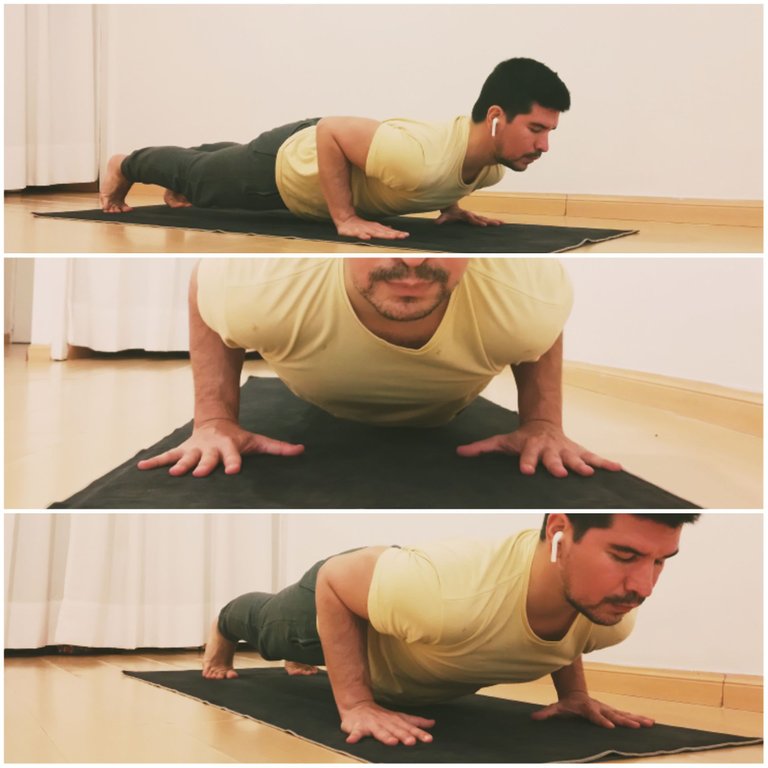
Esta postura suele ser realmente exigente, sobretodo para quienes inicia en la práctica del yoga, y es por ello que viendo la dificultad que se le presenta a las personas las primeras veces que la hacen, he decidido compartir algunoa tips del video.
Las tres opciones planteadas en el video, deben ser elegidas según el grado de dificultad que tengamos, asi que no deben hacerse todas juntas, pues resulta imposible.
Por ejemplo, si me es muy dificil sostener todo el peso de mi cuerpo sobre los brazos, pero aun asi quiero practicar la flexión, lo idea es utilizar un apoyo extra, al bajar las rodillas al piso. Sin embargo, mientras hacemos eso, no bajamos la cadera para no presionar la lumbar en cada repetición, sino que la elevamos a la misma altura que los hombros.
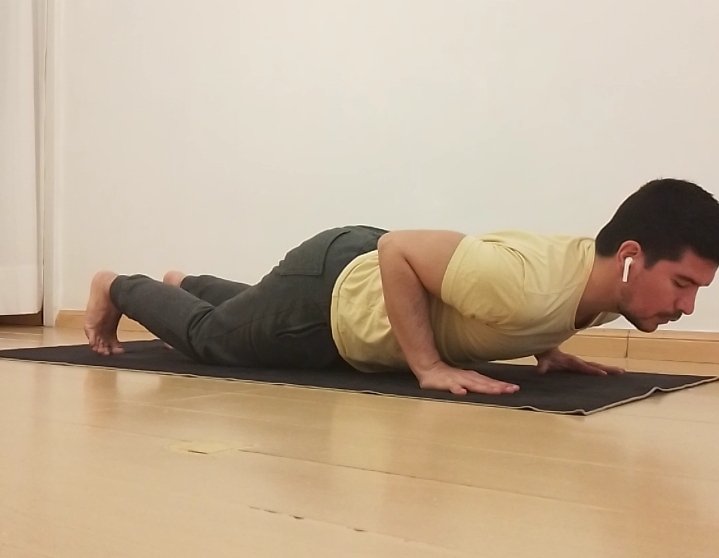
En la segunda opción, por ejemplo, no se trabaja la flexión de codos, pero si tenemos la oportunidad para realizar el cambio de posición de los pies cuando hacemos la transición al Urdvha Mukha Svanasana (Postura del perro cabeza arriba)
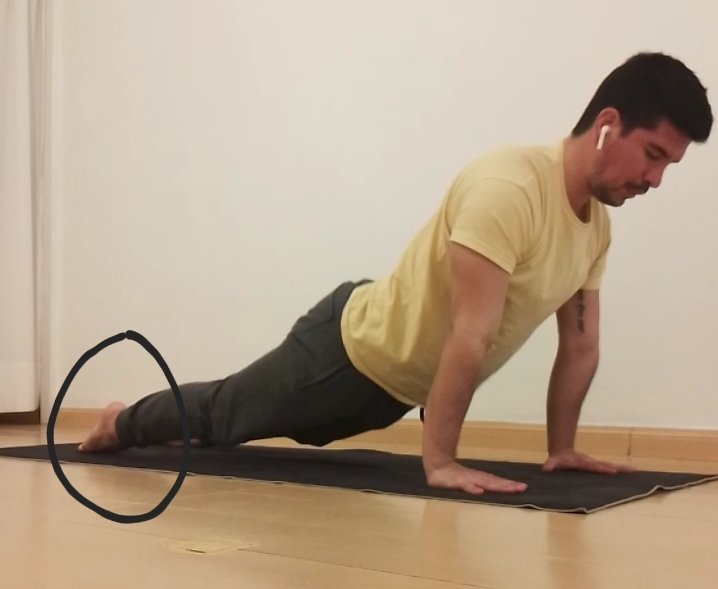
Y finalmente en la tercera opción, podemos ayudarnos con un apoyo extra, similar al de las rodillas, pero a lo largo del torso, colocando un segundo mat de yoga o un bloque debajo del pecho, para que bajemos hasta ese nivel y luego podamos subir a la siguiente postura; el Urdvha Mukha Svanasana.
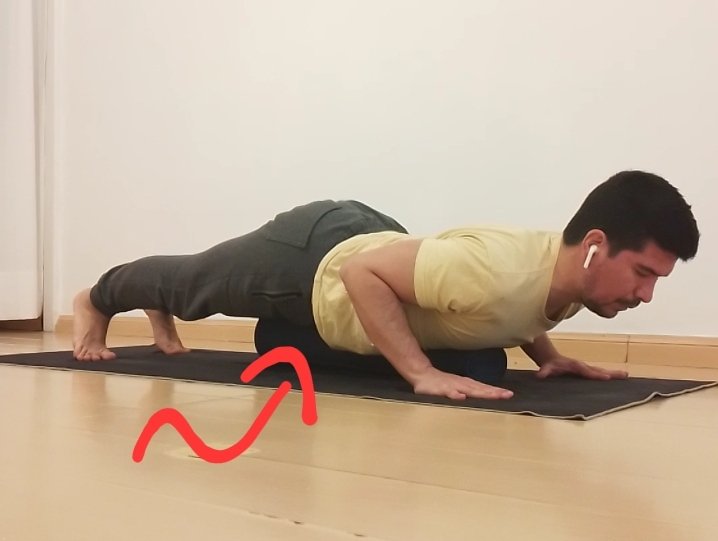
Posterior a estas opciones, en el video podemos ver como ejercicios complementarios, una secuencia de posturas que sugiero mantener 5 respiraciones o algunas repeticiones para fortalecernos y lograr la postura completa, algún día.
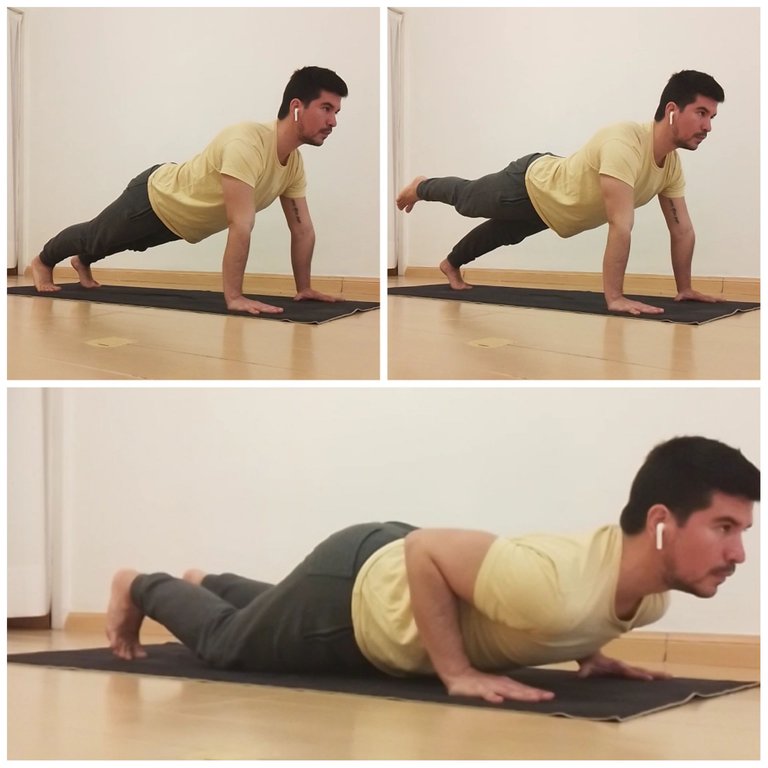
¿Qué beneficios tiene esta postura: Chaturanga Dandasana?
Desarrollaremos fuerza muscular en brazos, muñecas y hombros.
Tonificaremos el abdomen y las piernas.
Es una postura muy energetizante en la que todo el cuerpo se activa para sostenerse en una línea, con lo que nos ayuda a revitalizar cuerpo y mente.
Si quisieras replicar la práctica
Ten en cuenta que cada postura (donde permanecí unos segundos), tienen una duración estándar de 5 respiraciones completas. Y cuando finalizas la práctica, debes descansar al menos 5 minutos completamente tendido en el suelo, sin moverte y con ojos cerrados.
Espero que lo disfruten, si quieren empezar a practicar yoga, no dudes en escribirme, quedo a la orden.
ENGLISH
Today I have brought you a series of videos where I share with you a sequence of options to perform or improve a very important posture during the practice of Yoga: Chaturanga Dandasana.
In the complete video we can see three options to perform the sun salutation movement, in case you are not able to do correctly Chaturanga Dandasana. And in addition to these options, at the end there are some exercises as complements so that we can perform daily and thus further strengthen the arms, abdomen and back, to achieve the posture much better.
Chaturanga Dandasana
When we perform a sun salutation, the Chaturanga Dandasana posture, is the fourth posture to be performed.
Its name means: The staff of the four supports or stages. Referring to the fact that the spine remains completely rigid and straight, while only the two hands and two feet are supported.
In this way we see how the very name of the postures give us a clear idea of how the posture should be done.
Here is an image:

This posture is usually really demanding, especially for those who starts in the practice of yoga, and that is why seeing the difficulty that is presented to people the first times they do it, I decided to share some tips from the video.
The three options presented in the video, should be chosen according to the degree of difficulty we have, so they should not be done all together, because it is impossible.
For example, if it is very difficult for me to support all my body weight on my arms, but I still want to practice the push-up, the idea is to use an extra support by lowering my knees to the floor. However, while doing that, we don't lower the hips so as not to put pressure on the lumbar on each repetition, but raise them to the same height as the shoulders.

In the second option, for example, we do not work on elbow bending, but we do have the opportunity to perform the change of position of the feet when we transition to Urdvha Mukha Svanasana (Head Up Dog Pose).

And finally in the third option, we can help ourselves with an extra support, similar to the knees, but along the torso, placing a second yoga mat or a block under the chest, so that we go down to that level and then we can go up to the next posture; the Urdvha Mukha Svanasana.

Subsequent to these options, in the video we can see as complementary exercises, a sequence of postures that I suggest holding 5 breaths or a few repetitions to strengthen us and achieve the full posture, someday.

What are the benefits of this posture: Chaturanga Dandasana?
We will develop muscle strength in arms, wrists and shoulders.
We will tone the abdomen and legs.
It is a very energizing posture in which the whole body is activated to hold a line, which helps us to revitalize body and mind.
If you would like to replicate the practice
Keep in mind that each posture (where I stayed for a few seconds), have a standard duration of 5 full breaths. And when you finish the practice, you should rest for at least 5 minutes completely lying on the floor, without moving and with eyes closed.
I hope you enjoy it, if you want to start practicing yoga, do not hesitate to write me, I remain at your service.
If you would like to replicate the practice
Keep in mind that each posture (where I stayed for a few seconds), has a standard duration of 5 full breaths. And when you finish the practice, you should rest for at least 5 minutes completely lying on the floor, without moving and with eyes closed.
Also at the end of the sequence of postures (asanas in Sanskrit) that stretch the legs, we do a half bridge sequence as a counterposture to the forward bend we do, and close the practice with a twist of the spine and rest for 5 minutes in Savasana.
I hope you enjoy it, if you want to start practicing yoga, do not hesitate to write me, I remain at your service.
Cuéntame un poco más:
¿Pudiste hacer esta práctica o te interesaría aprender más sobre Yoga para principiantes en mis clases Online?
Tell me a little more:
Were you able to do this practice or would you be interested in learning more about Yoga for beginners in my Online classes?

Soy Julio Cesar Arvelo, practicante y profesor de Ashtanga Yoga y Meditación.
Si te gustó esta publicación y quieres seguir leyéndome, te invito a seguirme.
Todas las imágenes han sido tomadas desde mi cámara o creadas por mi, en Canva.com. El video ha sido editado a través de la aplicación móvil: Inshot y los creditos por la música corresponden a:
Música: A New Beginning
Músico: Agnese Valmaggia
URL
Licencia
Mi redes sociales:

▶️ 3Speak
La música 🎶 definitivamente va muy bien con los ejercicios que mostraste durante tu vídeo y explicas muy bien.
Gracias hermano!! Muy apreciado tu comentario, me motiva a seguir haciendo este tipo de post.
Abrazo!